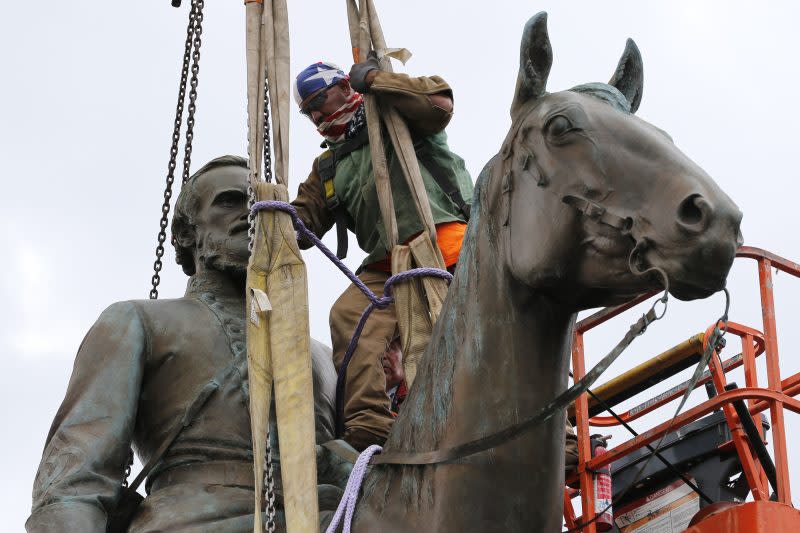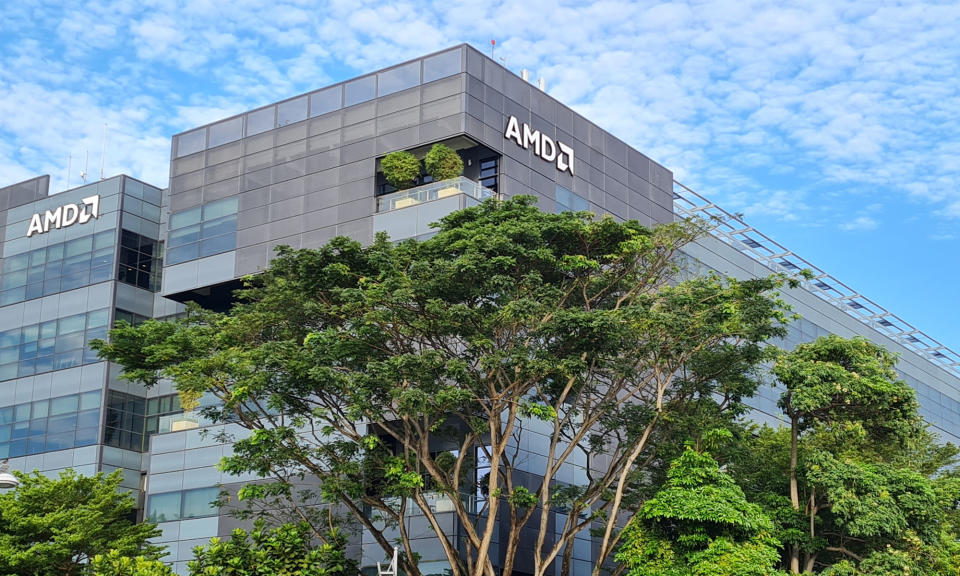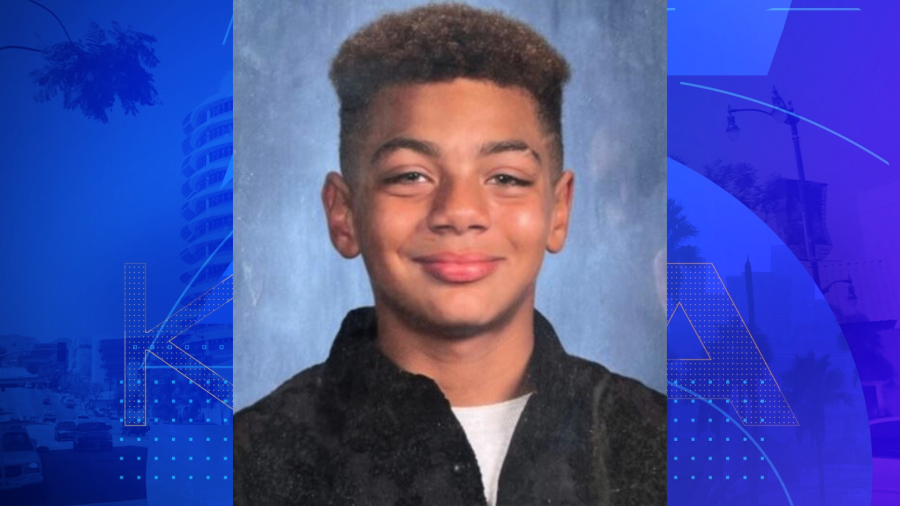The story of Bainbridge Island’s Mochi Tsuki festival starts in the Okano family’s dry cleaning business. It began when the Nakatas and the Okanos (two Japanese American Bainbridge Island families) partook in a common Japanese New Years tradition of making mochi. Joyce Nishimura, the secretary of Bainbridge Island Japanese American Community (BIJAC), who has attended Mochi Tsuki festival for “a good 30 years,” says that it was a way for the families to heal after the World War II atrocities, “or at least brought their family together.”
Nishimura has seen the festival grow greatly over that time — from the dry cleaner’s to Island Center Hall, the Filipino American Community Center, IslandWood, to Woodward Middle School, where Mochi Tsuki has been held for the last four years.
Far from its beginnings from a family gathering in a dry cleaning shop, this year’s festival on Saturday saw over 1,000 attendees who partook in mochi shaping, mochi pounding, obon dance classes, Taiko (Japanese drum) performances, origami making, and a presentation with the two artists who contributed to the Bainbridge Island Japanese Exclusion Memorial.
“It started as a family event because Japanese Americans at New Years make it a tradition to make mochi, as well as celebrate with the family. Mochi is about prosperity and health,” Carol Reitz, the president of Bainbridge Island Japanese American Community (BIJAC), said.
The festival is an opportunity to not just take part in making and eating delicious mochi, but also to learn about the rich history of Japanese Americans on Bainbridge Island. Reitz says that the “the purpose of the festival is to share the culture and the history of Japanese on Bainbridge Island. So one of the key things… is also educating people on what happened to Japanese Americans and the history of their living here on the island, especially what happened in 1942.”
Remembering history
Clarence Moriwaki stands on a stage above the hall where visitors stream in through the door to be directed to different areas of the festival. In front of the stage, people wait in a line to shape mochi at several long tables. Behind him stand informational signs about the history of Japanese Americans on Bainbridge Island, including their forced removal during World War II. Moriwaki is the former president of the Bainbridge Island Japanese American Exclusion Memorial Association and a Humanities Washington Speaker about the Japanese American exclusion.
What Moriwaki is there to answer questions about, and what Reitz and Nishimura are referring to, is Bainbridge Island’s unique history of being the first place in which Japanese Americans were forcibly removed and sent to American concentration camps. Bainbridge Island also had the highest return rate of Japanese Americans, something Moriwaki says it is because “this community really embraced their friends and neighbors. That was not something that happened in the rest of the country.” Even the name of the current venue has a connection to Japanese American incarceration, Moriwaki notes, “we’re in the Woodward School, which is named after Millie and Walt Woodward, who ran the only newspaper that editorialized for Japanese Americans and against the unconstitutional acts of the country.”
Moriwaki says that Japanese Americans helped build Bainbridge Island “through industry, through building their farms. It helped create this island, the growth of Winslow, and other places on the island. They were instrumental in helping make the island what it is today.” But he also notes that the contributions of industry Japanese Americans left wasn’t the biggest contribution.
“They helped shape what the community is, you know, and it wasn’t your racial, political, social, economic, or religious background. What was important was: how are you with your friends and neighbors? That’s the Bainbridge legacy. I think that’s what’s celebrated about Japanese Americans.”
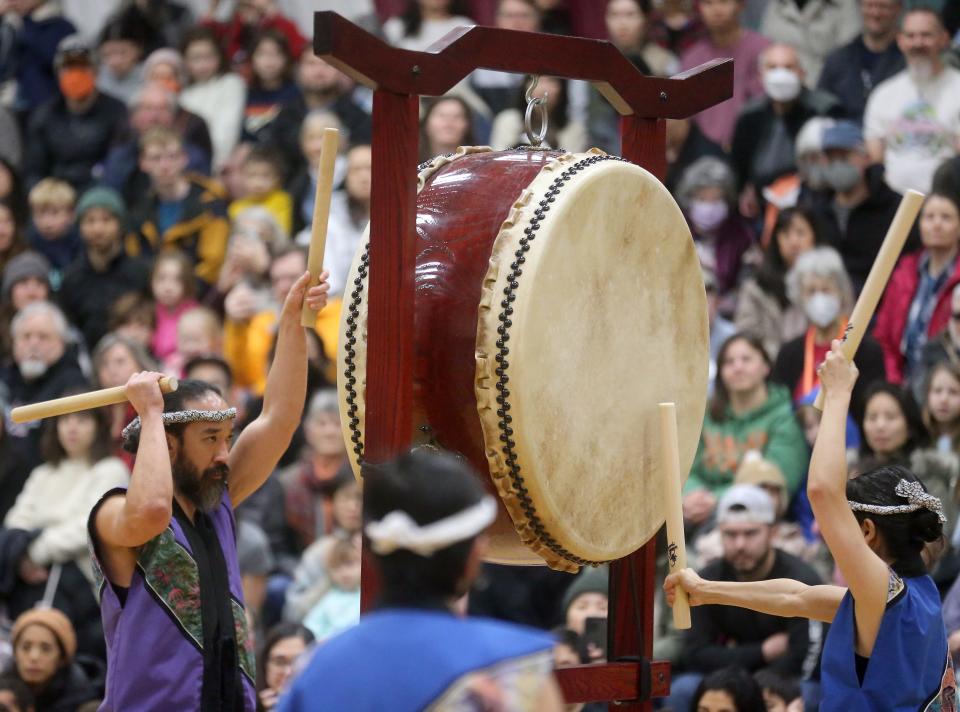
Taiko dancing
Past the presentation about Japanese American history on Bainbridge, there is Taiko dancing in the gymnasium by the group Seattle Kokon Taiko. Volunteers distributed 700 tickets, and sold out for the noon show, leaving people waiting at the door in case spots to watch opened up. In the gymnasium, the sounds of people cheering and drums pounding fill the room.
Leading Seattle Kokon Taiko is artistic director Lika Seigel. Seigel has been coming to the Mochi Tsuki Festival since for twenty years to perform with her group. She has also seen a small gathering grow into a massive event, something she describes as “amazing.”
“The Mochi Tsuki [Festval] brings the whole community together, and especially after COVID, we really appreciate this opportunity to more than ever, bring all the community together to celebrate a brand new year of hope.”
Seigel explains that Taiko is a relatively new form of ensemble. The word Taiko means “drum” in Japanese, and the instrument has been around for thousands of years. As an ensemble art it started in the 1950s with Daihachi Oguchi, a jazz drummer who “was given a music department and who decided that if he took that music, separated it into hi-hat, snare, and bass and had different people play it, we could come together and play something.” Taiko came to North America in 1968, when Grand Master Seiichi Tanaka started the San Francisco Taiko Dojo. Seattle’s group is considered third wave Taiko, founded in 1980.
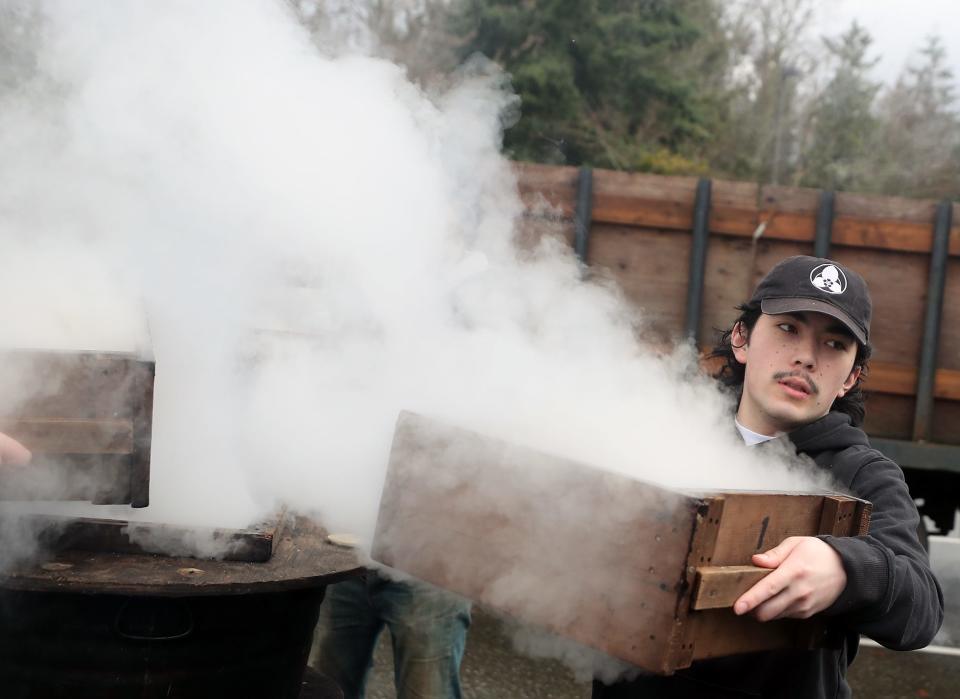
Mochi pounding
Outside, Mike Okano and Tony Egashira stand next to a large stone bowl, behind them a stack of wooden boxes sits over an open fire. Inside, sweet rice is steamed, and then moved to the stone bowl called a usu, where people, directed by Egashra, circle around, mallets in hand, and pound the sweet rice to make mochi.
“Ichi, ni, san, shi!” Egashira leads a chant, (one, two, three, four in Japanese).
Egashira has been taking part in the Mochi Tsuki Festival for twenty years, since he was thirteen. This year he supervised the pounding of the mochi, taking over for longtime mochi master Shoichi Sugiyama, who recently retired. Before Egashira goes to start another round, he quickly has time to share his favorite part about the festival “just the community coming together here,” he says.
Next to him stands Okano, whose family started the Mochi Tsuki Festival all those years ago. “It was my stepmother’s idea. My dad agreed on it. And we actually did it in our dry cleaning business for about six years, and then we got tired of doing it. And then this is what it became.”
Okano doesn’t have an answer for why the Mochi Tsuki Festival got to be so popular.
“It just grew! I mean, nobody does it, everybody wants it, chances are it’s never going to end. I may not be here, but we have the younger crowd that comes in and does it.”
“The third generation,” Egashira laughs.
Coming to learn from around Puget Sound
Cassie Miura traveled from Tacoma with her daughter, where she works in Asian American Studies at University of Washington, Tacoma. Muira heard about the Mochi Tsuki Festival from a colleague.
“I’m Japanese American. I’ve never been to the festival, and my kids and I have been talking about mochi making with the New Year and I wanted them to witness it firsthand.”
Miura’s friend, Tabitha Espina, said that she was excited to attend because it was “an opportunity for the community to get together and learn more about the history of Japanese Americans in the island. And so that’s something that I’m enjoying overall, because it’s a history that I had absolutely no idea about prior to attending.”
Many of the attendees of Mochi Tsuki Festival were families, like Veroncia Ivey Sawin, who attended the festival for the second time with her children Egan and Amelia.
“I think it’s a great community event and it’s fun to support it. And we have some friends who are involved in organizing it. I took Japanese through high school at Bainbridge High School, and it’s just a great community event to be involved with,” Sawin said.
When asked why they like coming to the Mochi Tsuki Festival, Egan and Amelia said they loved eating the mochi and seeing the lion costume in the Taiko performance.
At the other end of the age spectrum, the elder volunteers of the Mochi Tsuki Festival reminisce about when it was a small gathering in community halls.
Nimashura talks about people gathered at long tables for a potluck style meal, and reminisces over powder fights and when an organizer would walk around with a boom box propped on his shoulder to listen to a football game because “he couldn’t miss the Huskies playing.”
Bill Nakao, a volunteer at the Mochi Tsuki Festival and for BIJAC says that though the event has grown, it has retained its community feel, though some of the elderly people find it to be overwhelming now. He loves seeing “all the people who come out to go to this…hundreds of people do come out and do this. And I think that’s the thing that I remember the most is how well attended it is and how many people must look forward to it.”Nakao, Nimashura and Moriwaki all reference “Nidoto nai yono”, or, let it not happen again. This is the motto and mission for the Bainbridge Island Japanese Exclusion Memorial.
“It’s really important to share our history, but also to make people aware of all ethnic histories. In 2015 when they were having all the refugees leave Syria, there were people in the government who said, ‘we should just incarcerate these people you know, we have a precedent for it, looking at the Japanese during World War II.’ We have to stop that kind of thinking. And so I think making people more aware of the different cultures and being tolerant and accepting of the different cultures is really important. And that’s a little bit of what we’re doing here,” Nakao said.
“This is not a Japanese American story. It’s an American story. And we worked on the title ‘nidoto nai yono’ — let it not happen again, for a long time,”Moriwaki said. “It’s not to blame, or guilt, or shame. It’s to inspire. It’s inspirational and it’s aspirational.”
This article originally appeared on Kitsap Sun: Rice pounding, drumming at Bainbridge Island Mochi Tsuki festival
Signup bonus from



